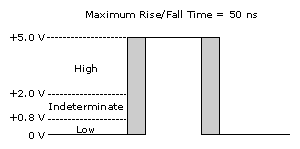Digital Signals
A digital signal has two discrete levels—a high and a low level. One example of a digital signal is a transistor-transistor logic (TTL) compatible signal. A TTL-compatible signal has the following characteristics:
- 0 V to 0.8 V = logic low
- 2 V to 5 V = logic high
- Maximum rise/fall time = 50 ns

Digital devices can monitor the state of the pulse and can transition the pulse from one state to another. A counter can also monitor the state as well as detect rising edges, a transition from logic low to logic high, and falling edges, a transition from logic high to logic low. Counters are used commonly to count edges and for time measurements, such as measuring digital frequency or the period of a signal.